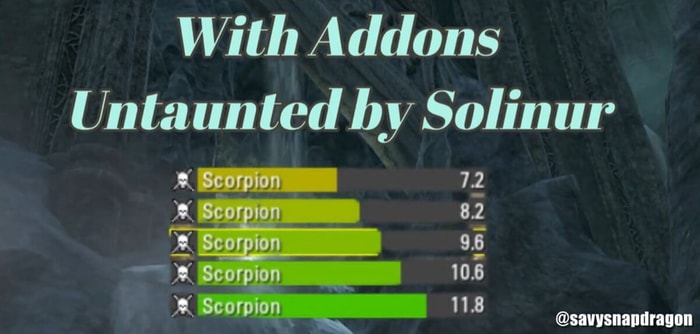In The Elder Scrolls Online, a tank is a character with heavily armored gear who plays the role of the group's shield. Their primary objective is to lead the charge into combat and absorb incoming damage while also protecting and defending the rest of the group against any threat. A tank's job is to grab the attention of enemy targets and control their focus, forcing them to attack the tank and minimizing damage to the other members of the group, such as damage dealers and healers.
In this guide, SavySnapdragon will share the main features of tanking in The Elder Scrolls Online, along with some unwritten rules and common courtesies you can follow while tanking. Even if you don't plan on tanking yourself, knowing what your tanks have to try to keep up with and manage while doing their job can help you be a better teammate.
The Role of a Tank
One of the most important roles in group content is that of a tank. A tank's role is complex and can be broken down into five key steps:
1. Hold Agro: The primary duty of a tank is to hold aggro of enemies through a taunt.
2. Position Enemies: A great tank knows that positioning is crucial.
3. Debuff Enemies: Tanks aren't just there to take hits. They can also play a crucial role in weakening enemies. Debuffing is a significant part of their job.
4. Buff Teammates: While the tank focuses on controlling the battlefield, they also have an important responsibility to buff their teammates to enhance their damage output, healing received, and other valuable stats.
5. Survive: Tanks must also look out for themselves. They use abilities and gear to increase their survivability, damage mitigation, self-healing, and shields. All these tools help a tank withstand the relentless onslaught of enemies.
Tank Armor
In ESO, one of the ways to improve your tank's survivability is with armor. Heavy armor is going to provide the highest armor rating. But there are additional passive benefits, too, including passive damage reduction, passive Physical and Spell Resistance, passive Health Recovery, passive resource regeneration, passive increase in Max Health, and increased healing received.
Another commonly missed way to improve your tank is to have at least one piece of light and medium armor in your setup. The Undaunted passive kicks in, increasing your Max Health, Magicka, and Stamina by 2% for each type of armor, up to a maximum of 6%. So don't be afraid to try out other pieces of armor besides heavy armor.
Tank Weapons
When starting your tanking adventure, you will commonly see a Sword and Board used for one bar and an Ice Staff used for the other bar. Understanding the benefits of these two weapons can help you better use them.
Sword and Board
The Sword and Board setup provides significant advantages, including reduced cost of blocking, increased amount of damage that can be blocked, and access to a valuable taunt skill that applies a debuff called Breach.
Ice Staff
The Ice Staff has unique advantages over the other destruction staves, including reduced cost of blocking, increased damage you can block, and a taunt skill that applies Chilled. Furthermore, it also allows converting block cost to Magicka if the Tri Focus passive is purchased.
Tank Skills
ESO offers remarkable flexibility, allowing players to shape their character with various skills and abilities. The wealth of choices can be overwhelming when allocating ten skill slots and two Ultimate slots. Let's explore the crucial elements that every tank should have.
1. Taunt
2. Chains
3. Stun/Snare
4. Self Heal
5. Buff Focused Ultimates
Taunt
In the Elder Scrolls Online, taunting is fundamental for the tank role. You can opt for a powerful melee taunt like Puncture, which not only taunts but also debuffs your enemies. Alternatively, there are taunts, such as Frost Clench or Inner Fire, for enemies beyond your immediate reach.
Chains
Tanks typically use chaining abilities, such as Silver Leash. These abilities aid in drawing in smaller enemies not already grouped with the primary threat, ensuring better control of the battlefield.
Stuns and Snares
Tanks use Stuns or Snares, such as Dark Talons, Caltrops, or Gripping Shards. These abilities slow down or immobilize enemies, allowing you to maintain order and control during a battle.
Self Heal
Tanks should have their own self-healing skill. While healers provide support, it's prudent to have a self-healing skill in your arsenal for those moments when you might be out of reach or need some extra heals that the healer might not be able to provide immediately. Consider abilities like Resolving Vigor, Green Dragon Blood, or Hungry Scythe that focus on your personal resilience. This self-sustain can be a lifesaver in challenging situations when your healer is occupied elsewhere.
Tank Ultimates
In The Elder Scrolls Online, when tanks select what Ultimate to use, they should prioritize those that benefit the entire team, such as Aggressive Horn. These abilities offer valuable buffs that enhance the overall performance of your group.
Tank Taunt Skills
Tanks need to taunt, and here are the skills that can taunt the enemies:
• Pierce Armor is a melee Sword and Board skill that also provides a couple of key debuffs.
• Frost Clench is a ranged frost-staff skill that also applies the debuff called Chilled.
• Inner Fire and its morphs are ranged taunts in the Undaunted skill line.
Soft Taunt
There are situational or soft taunts that were added in Update 37. These skills also provide a taunt if the enemy is not already taunted.
• Silver Leash is a Fighters Guild skill that also pulls enemies in.
• Fiery Grip and its morphs are Dragonknight skills that can pull enemies in.
• Beckoning Armor is a Necromancer skill that additionally pulls in ranged enemies.
• Runic Jolt and its morphs are Archinist skills that provide a ranged taunt.
Positioning
Tanks not only need to pull aggro but also need to position enemies. Here are a couple of tips to help you with positioning.
1. Ensure that the enemy faces away from your team. Certain foes possess a frontal cleave attack that, although manageable for a tank, can prove disastrous for your more vulnerable teammates.
2. Once in position, try to hold as still as possible unless mechanics require you to move. Excessive movement on the part of the tank complicates the tasks of the damage dealers and healers. This is because damage dealers often use area-of-effect damage, and unnecessary enemy displacement can reduce the group-wide damage output. Healers, too, rely on area-of-effect heals, so excess tank movement can disrupt their ability to support the team's overall buffs via healing effectively.
Dedicated Tanking
In The Elder Scrolls Online, the role of a tank differs slightly from that in other games. Instead of focusing on dealing damage, ESO tanks primarily concentrate on debuffing enemies and buffing their fellow teammates. This unique approach, which incorporates gear sets, skills, passives, Champion Points, and various other details, showcases the true strength of a good tank. Such a tank excels in enhancing group damage more effectively compared to a flex tank, who attempts to balance their gear and skills between tanking and damage dealing.
It's important to note that the damage output of a flex tank will considerably fall short to that of a dedicated damage dealer setup. However, the real power of a standard damage dealer setup can be further amplified through the proper support of a tank who applies debuffs to enemies and provides buffs to allies. This synergy between tank and damage dealers creates a dynamic and formidable combination that maximizes group damage potential.
Trash Packs
In group content, enemies usually come in large packs referred to as Trash. There are a lot of them, and most of them are usually inconsequential. But if they are allowed to mob non-tank teammates, they can cause problems. There are multiple ways to manage Trash pulls:
1. Be the first to engage the pack if you can. Lead with an AoE attack to start unless there are particular enemies that are more dangerous. Then, lead with a direct taunt on that enemy.
2. Use some type of skill that either slows down, stuns, immobilizes, or snares the enemy.
3. Chain any remaining enemies to the center of your stack.
4. For any enemies that are still alive, apply additional buffs and debuffs. This basic strategy is a great start.
A key note is that you don't have to taunt every enemy. The goal is to get them grouped up so your team can kill them before they can hit anyone.
Enemy Types
As a tank, knowing the enemies and their attack patterns will serve you well. This can either come through reading guides or just experience. Outside of specific mechanics, a great feature to quickly identify an enemy is whether they are melee or ranged.
Melee enemies typically either have no weapons or have melee weapons like as daggers or two-handers.
Ranged enemies will typically have either a bow or a staff. This is useful for stacking purposes, as ranged enemies will not come towards you when just range-taunted and sometimes even resist getting pulled into the group. Therefore, tanks identify the ranged enemies, snare the ranged enemies, and pull the melee enemies on top of the ranged enemies for a cleaner stack.
Line of Sight
In The Elder Scrolls Online, battles seldom occur in barren landscapes. The set designers incorporate a diverse array of elements to enhance the visual appeal of the combat arenas. These elements can be strategically utilized if you grasp the concept of line of sight.
To land attacks, enemies aim to maintain a clear line of sight to their intended targets. Consequently, as a tank, you can provoke the attention of multiple enemies. Instead of attempting to draw them all to a single location, you can cleverly position yourself behind obstructions, such as crates or trees, forcing the enemies to readjust their position to maintain visual contact with you. This tactic is particularly effective against foes that are challenging to relocate, such as archers or oversized creatures that cannot be easily pulled using chains. Feel free to experiment with this approach and identify the optimal positions for grouping various enemies. Mastering the best locations will require practice to determine what suits your style most effectively.
Set the Pace
In group content of The Elder Scrolls Online, there's an unspoken rule that tanks should lead when initiating encounters. Just as there are overeager teammates who rush ahead of the tank and cause frustration, a tank moving at a snail's pace can also be frustrating to the group. That's why tanks must maintain a reasonable pace between fights.
Many damage dealers depend on stacking buffs or keeping specific bonuses active, which can lose effectiveness if they stay out of combat for extended periods. Therefore, tanks who stop to prepare with an extensive series of pre-buff skills can often be excessive in most situations. However, this does not mean tanks should prioritize Swift jewelry or other movement speed buffs. As a tank, you set the pace for your group. When your group allows you to initiate pulls, it is essential to be efficient and not keep them waiting. Take the lead and jump into action. Your group will appreciate the seamless flow of combat, and everyone can maximize their efficiency during encounters.
Tracking Taunts
When encountering multiple enemies to taunt, keeping track of taunts can be tricky. So, let's cover an add-on-free and add-on-assisted way of tracking.
Without Add-Ons
Without any add-ons, the best way to keep track of taunted enemies is to use the in-game timer on your taunt skill. Unfortunately, this will only help tell the amount of taunt left on the most recently taunted enemy. So, you will have to use a bit of deduction.
For example, if you taunted three enemies and cast those taunts back to back, you have 12 seconds left on the first taunt by the time you cast the third taunt. Therefore, when the timer starts getting down to 5 seconds left, you should start refreshing the taunts on those three enemies again.
With Add-Ons

Add-ons, such as Untaunted (by Solinur), put a bar with a countdown for every enemy you have taunted. This is easier for tracking but does clutter up your screen. Therefore, some tweaking of the settings for size and color is needed to optimize this to your preference.
Over Taunting
In ESO, there is a concept called over-taunting: An enemy can become immune to taunts and potentially target non-tank allies until a 15-second timer expires. Fortunately, the conditions required to trigger over-taunting are highly specific, making it unlikely to encounter.
There are certainly multi boss situations that call for tank swaps, so knowing how to avoid this mistake can be helpful. The prerequisites for over-taunting are as follows:
1. There must be two tanks or teammates equipped with taunts.
2. The target enemy needs to be taunted for a total of five times by both tanks within a 15-sec window. This scenario is challenging to orchestrate and, moreover, inefficient in terms of resource utilization for one or both of the tanks. This is because each taunt has a 15-second duration, rendering the repetition of taunts within such a short period of time unnecessary.
Common Buffs
The most common buffs tanks provide include Minor Courage, Major Force, and additional Weapon and Spell Damage.
The primary method for acquiring the buffs includes using gear or skills. For instance, you can equip gear like Claw of Yolnahkriin for Minor Courage, and the skill called Aggressive Horn provides Major Force. Also, sets like Pearlescent Ward or Powerful Assault can be used to boost your Weapon and Spell Damage further.
Those buffs can be procured through various methods, so don't hesitate to experiment and discover what works best for your character.
Common Debuffs
Tanks are expected to debuff enemies. The most common debuffs include Minor and Major Breach, Major Vulnerability, armor reduction, and Minor Brittle. The most frequently employed methods for obtaining abilities that apply debuffs are the use of specific gear and skills. For example, you can utilize the skill called Puncture to inflict Major Breach on the enemy. The gear Turning Tide applies Major Vulnerability. Tremorscale is commonly used to reduce armor. Lastly, an ice staff with the skill named Elemental Wall can be used to apply Minor Brittle.
Distinguishing Attacks
When starting tanking in the Elder Scrolls Online, every novice tank must familiarize themselves with the art of distinguishing between attacks to block, those to dodge, and those to endure head-on. This proficiency is curated through a process of trial and error, accumulating experience from encounters with each specific boss. However, this guide can offer some essential tips to assist you in your decision-making process.
Block If It Is Just a Channeled Attack
When facing a boss executing a channeled attack, pay attention to signs like noticeable wind-up, distinct animations, or visual effects. These are signals that you should consider blocking the impending assault.
Dodge If Channeled Attack + Extra
Consider dodging if the channeled attack not only exhibits the aforementioned cues but also leaves an Area of Effect hazard beneath your feet or necessitates movement for some other reason. A well-timed dodge roll can be effective in this choice.
Prioritize Blocking
Blocking should be your initial choice because it consumes less Stamina than roll-dodging. Additionally, blocking helped maintain the boss's position more effectively, compared to roll dodging. Blocking also offers a margin of error if your timing is slightly off.
Stamina Regeneration
A crucial aspect many new tanks overlook is that while in the blocking stance, your Stamina regeneration comes to a complete halt, irrespective of your buff food or potions that you consume. This underscores the significance of a tank's ability to discern when to maintain a blocking posture, relying on their experience to judge when it's safe to execute a heavy attack with the Sword and Board or when to break block. These heavy attacks are the lifeblood of tanking as they restore Stamina, which is used in both blocking and roll dodging, along with various skills.
Conclusion
In conclusion, diving into the world of tanking in The Elder Scrolls Online opens up a whole new dimension of gameplay and strategy. The role of a tank goes beyond simply absorbing damage. It's about controlling the battlefield and maximizing your team's overall effectiveness. Whether you're a seasoned tank looking for tips to refine your skills or a newcomer eager to embrace the role, understanding the intricacies of tanking will enhance your ESO experience. Remember, the journey to becoming a formidable tank is ongoing, filled with experimentation, learning, and adapting to the challenges Tamriel throws your way.
The ESO community is vast and supportive, so don't hesitate to seek advice, join discussions, and share your experiences with fellow adventurers. During your tanking adventures, keep in mind that versatility and communication are key. Stay vigilant, own your skills, and, most importantly, enjoy the rewarding feeling of being the guardian that stands between your group and the perils of Tamriel.
Last but not least, if you found this guide helpful, please thumbs up and subscirbe to SavySnapdragon's channel for more helpful content. May your armor be strong, your taunts be effective, and your adventures be epic. Happy tanking in The Elder Scrolls Online!
YOU MAY ALSO LIKE:
Best Classes for Tanking in ESO 2023



